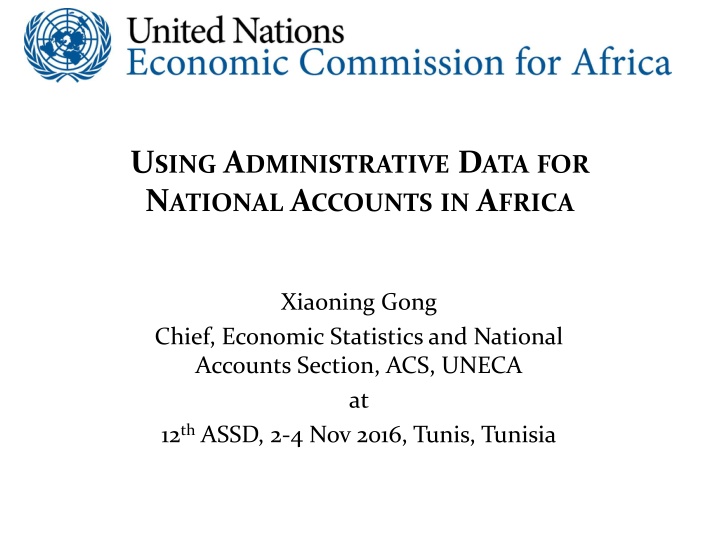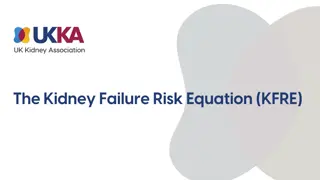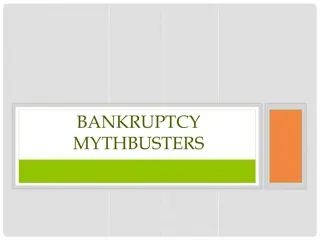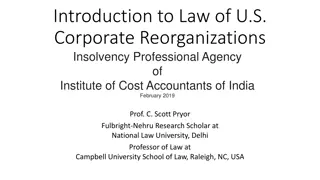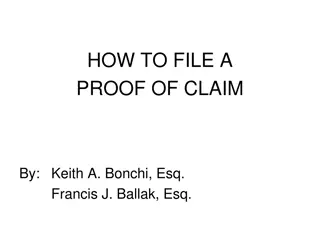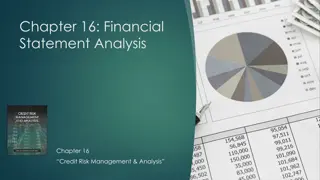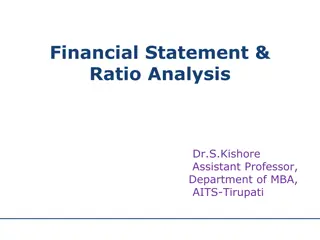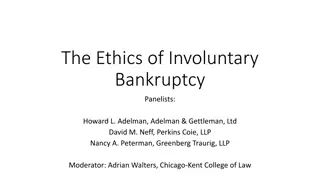Financial Statement Analysis: Bankruptcy Risk and Prediction Models
Empirical studies analyze bankruptcy risk by distinguishing financial characteristics of firms. Models like Altman's Z-score and logit scoring help predict bankruptcy using ratios like Net Working Capital/Total Assets, Retained Earnings/Total Assets, etc.
Download Presentation

Please find below an Image/Link to download the presentation.
The content on the website is provided AS IS for your information and personal use only. It may not be sold, licensed, or shared on other websites without obtaining consent from the author.If you encounter any issues during the download, it is possible that the publisher has removed the file from their server.
You are allowed to download the files provided on this website for personal or commercial use, subject to the condition that they are used lawfully. All files are the property of their respective owners.
The content on the website is provided AS IS for your information and personal use only. It may not be sold, licensed, or shared on other websites without obtaining consent from the author.
E N D
Presentation Transcript
USING ADMINISTRATIVE DATAFOR NATIONAL ACCOUNTSIN AFRICA Xiaoning Gong Chief, Economic Statistics and National Accounts Section, ACS, UNECA at 12thASSD, 2-4 Nov 2016, Tunis, Tunisia
Outline of the Presentation Sources of data for GDP government accounts financial corps non-financial corps external trade statistics tax data The needs for using administrative data for NA Features of the operational guidebook Summary of experiences Economic Commission for Africa www.uneca.org
Background: Why Admin Data? Administrative sources constitute a key component in national accounts compilation in most countries. Advantages of administrative data o Reduced costs; Better coverage; Improved timeliness; Reduced response burden; generally available, and can be efficiently used to improve the national accounts and implement 2008 SNA. Identified by AGNA as a priority area o To develop an operational guidebook on processing data from administrative sources in national accounts Economic Commission for Africa www.uneca.org
Figure 1. Sources for GDP and Statistical Business Register (SBR): (Number of countries citing source) Total for GDP GDP(P) GDP(E) GDP (I) CENSUSES and SURVEYS Population census 30 17 10 57 Household Income and Expenditure Survey 22 40 17 79 Agriculture census/survey 37 12 11 60 General economic census/survey 26 14 15 55 Services industries census/survey 26 12 9 47 Retail census/survey 20 8 9 37 Transport survey 19 8 10 37 Household labour force survey 23 16 12 51 Capital expenditure survey 10 12 6 28 Living Standards Measurement Survey (World Bank) 14 6 4 24
Figure 1. Sources for GDP and Statistical Business Register (SBR): (Number of countries citing source) (Cont d) Total for GDP GDP(P) GDP(E) GDP (I) CENSUSES and SURVEYS Demographic survey 12 7 5 24 Health survey 6 6 6 18 Multiphase 1-2 Survey on informal activities 12 7 5 24 Multiphase 1-2-3 Survey on informal activities 13 6 6 25 Other survey of informal activities 12 7 5 24 Surveys of international travellers 11 6 4 21 PRICES Consumer prices 34 31 7 72 Wholesale prices 13 6 1 20 Producer prices 31 10 3 44 Unit values or price indices for imports 14 22 1 37 Unit values or price indices for exports 16 23 1 40
Figure 1. Sources for GDP and Statistical Business Register (SBR): (Number of countries citing source) (Cont d) Total for GDP GDP(P) GDP(E) GDP (I) WAGES and EMPLOYMENT Wages of government employees Wages of other public sector employees Wages of private sector employees Number of employees in government Number of employees in other public sector Number of employees in the private sector TAXES and SOCIAL SECURITY TRANSACTIONS Value added taxes Other taxes on products Income tax on persons Income tax on businesses Customs duties/excise tax Other types of tax data Social security contributions or benefits 28 22 14 35 33 29 18 13 11 17 15 14 21 18 21 8 7 8 67 53 46 60 55 51 37 40 15 21 33 6 21 14 17 12 13 12 6 12 11 11 13 15 7 4 15 62 68 40 49 52 16 48
Figure 1. Sources for GDP and Statistical Business Register (SBR): (Number of countries citing source) (Cont d) Total for GDP GDP(P) GDP(E) GDP (I) GOVERNMENT and COMPANY ACCOUNTS Government accounts Government Finance Statistics (GFS) Company accounts Utility company records : water and electricity Transport company records rail, roads, and air GOVERMENT REGULATION STATISTICS Building permits Building completion certificates Vehicle registration Bank supervisory statistics Insurance supervisory statistics Other regulatory and administrative statistics EXTERNAL TRANSACTIONS Balance of payments Merchandise trade statistics 38 30 39 38 37 26 25 20 11 9 17 13 20 10 10 81 68 79 59 56 14 5 23 35 34 8 7 4 6 3 2 3 9 24 11 32 56 56 13 12 12 3 10 2 29 27 31 30 10 8 70 65
Figure 2. Ten Most Important Source for GDP (Number of countries citing source) All GDP estimates GDP(P) GDP(E) GDP (I) STATISTICAL SOURCES Household income and expenditure survey 40 17 79 Agriculture census/survey 37 General economic census/survey 15 Wages of private sector employees 21 Consumer prices 34 31 72 Unit values or price indices for imports 22 Unit values or price indices for exports 23
Figure 2. Ten Most Important Source for GDP (Number of countries citing source) (Cont d) All GDP estimates GDP(P) GDP(E) GDP (I) ADMINISTRATIVE STATISTICS Wages of government employees Wages of other public sector employees Number of employees in government Value added taxes Other taxes on products Income tax on persons Income tax on businesses Government accounts Government Finance Statistics (GFS) Company accounts Utility company records : water and electricity Transport company records rail, roads, and air Bank supervisory statistics Insurance supervisory statistics Balance of payments Merchandise trade statistics 18 21 18 67 35 37 40 62 68 13 15 17 13 20 38 26 25 20 81 68 79 39 38 37 35 34 31 30 70 65
Figure 3. Government Revenue broken down by department or ministry Number of countries Percent All Yes No Yes No Available only for national government 47 19 28 40,4 59,6 Available for both national and provincial governments 47 23 24 48,9 51,1 Available for local governments 47 30 17 63,8 36,2 Available for autonomous government bodies 47 19 28 40,4 59,6 Not available for any levels of government 47 4 43 8,5 91,5
Figure 4. Government Expenditure broken down by department or ministry Number of countries Percent All Yes No Yes No Available only for national government 47 20 27 42,6 57,4 Available for both national and provincial governments 47 25 22 53,2 46,8 Available for local governments 47 31 16 66,0 34,0 Available for autonomous government bodies 47 22 25 46,8 53,2 Not available for any levels of government 47 2 45 4,3 95,7
Figure 5. Government accounts in electronic form Number of countries Percent All Yes No Yes No Only for national government 47 22 25 46,8 53,2 Both national and provincial governments 47 18 29 38,3 61,7 Local governments 47 23 24 48,9 51,1 Autonomous government bodies 47 15 32 31,9 68,1 Not accessible for any levels of government 47 4 43 8,5 91,5
Figure 6. Detail in government accounts makes it possible to covert data to SNA definitions: Number of countries All Yes Percent No Yes No Distinguish economic category such as wages, intermediate consumption, transfers, etc.) Break down government expenditures by COFOG 47 42 5 89,4 10,6 47 29 17 61,7 36,2 Break down government expenditures by kind of economic activity 47 29 18 61,7 38,3 Distinguish between current and capital expenditures Distinguish between administrative departments and departmental enterprises 47 38 9 80,9 19,1 45 22 23 48,9 51,1 Distinguish between different types of taxes and subsidies 46 33 13 71,7 28,3 Distinguish between taxes and receipts from sales Distinguish between subsidies/current transfers/social transfers in kind Compile sequence of accounts for general government up to financial accounts 46 33 13 71,7 28,3 46 29 17 63,0 37,0 46 11 35 23,9 76,1
Figure 7. Availability of Central Bank data Number of countries Percent All Yes No Yes No Available separately for monetary policy, regulatory activities, and banking operations 46 15 31 32,6 67,4 Only consolidated accounts for total central bank are available 46 19 27 41,3 58,7 Not available at all 46 12 34 26,1 73,9
Figure 8. Availability of annual financial statements of banks Number of countries Percent All Yes No Yes No Available for each individual bank 46 29 17 63,0 37,0 Consolidated accounts of all banks available 46 11 35 23,9 76,1 Not available at all 46 5 41 10,9 89,1
Figure 10. Data available on life and non-life insurance Number of countries Percent All Yes No Yes No Life insurance Available for each individual company 46 31 15 67,4 32,6 Consolidated accounts of all life insurance companies 46 7 39 15,2 84,8 Not available at all 46 8 38 17,4 82,6 Non-life insurance Available for each individual company 46 34 12 73,9 26,1 Consolidated accounts of all non-life insurance companies 46 8 38 17,4 82,6 Not available at all 46 4 42 8,7 91,3
Figure 11. Availability of financial statements of non-financial corporations Number of countries Percent All Yes No Yes No Public corporations Available for individual companies and possible to identify by kind if activity 46 37 9 80,4 19,6 Available for individual companies but not possible to identify kind of activity 46 1 45 2,2 97,8 Consolidated accounts for all companies available disaggregated by kind of activity 46 3 43 6,5 93,5 Consolidated accounts for all companies available without disaggregation by kind of activity 46 0 46 0,0 100,0 Not available 46 6 40 13,0 87,0
Figure 11. Availability of financial statements of non-financial corporations (Contd) Number of countries Percent All Yes No Yes No Private corporations Available for individual companies and possible to identify by kind if activity 45 30 15 66,7 33,3 Available for individual companies but not possible to identify kind of activity 45 2 43 4,4 95,6 Consolidated accounts for all companies available disaggregated by kind of activity 45 1 44 2,2 97,8 Consolidated accounts for all companies available without disaggregation by kind of activity 45 0 45 0,0 100,0 Not available 45 12 33 26,7 73,3
Figure 12. Availability of data on Value Added Tax (VAT) Number of countries Percent All Yes No Yes No 46 23 23 50,0 50,0 Output, value added and tax collections by activity 46 15 31 32,6 67,4 Output, value added and tax collections by product 46 7 39 15,2 84,8 Consolidated output, value added and tax collections with no activity or product detail 46 6 40 13,0 87,0 Only tax collections data available by activity 46 7 39 15,2 84,8 Only tax collections data available by product Only tax source for the national accounts collections data available with no details by product or kind of activity 46 6 40 13,0 87,0 46 6 40 13,0 87,0 No data is available on VAT
Figure 13. Availability of data on income taxes on enterprises Number of countries Percent All Yes No Yes No Income and tax collections by activity available 46 28 17 60,9 37,0 Only consolidated data on income and tax collections available 46 14 32 30,4 69,6 No data available on income taxes paid by enterprises 46 5 41 10,9 89,1
Figure 14. Use in the national accounts of financial statements of financial corporations Number of countries Percent All Yes No Yes No Central bank accounts are used in NA 45 31 14 68,9 31,1 Accounts of banks are used in NA 46 39 7 84,8 15,2 Accounts of insurance companies are used in NA 46 38 8 82,6 17,4 Financial statements are not used in NA 44 3 41 6,8 93,2
Figure 15. Use in the national accounts of financial statements of non-financial corporations Number of countries Percent All Yes No Yes No Information contained in the financial statements are used in the NA 45 40 5 88,9 11,1 Not used 45 5 40 11,1 88,9
Figure 16. Use of VAT data in NA compilation Number of countries Percent All Yes No Yes No Data used in NA compilation by activity 47 34 13 72,3 27,7 Data used in NA compilation in other areas 46 8 38 17,4 82,6 VAT data is not used in NA compilation 46 3 43 6,5 93,5
Figure 17. Use of data on income taxes on enterprises in NA Number of countries Percent All Yes No Yes No Data used in NA compilation by kind of activity 46 27 19 58,7 41,3 Data used in NA compilation in other areas 46 6 40 13,0 87,0 Not used in NA compilation 46 16 30 34,8 65,2
Figure 18. Use of BOP and External Trade Statistics Number of countries All Yes 47 43 Percent No 4 Yes 91,5 No 8,5 Trade data by product according to HS/SITC for NA compilation Unit value indices of imports and exports used to deflate current price data Information on imports and exports of services used GDP(E) Information on primary incomes and property incomes used for sequence of accounts (SOA) Information on current transfers used for secondary distribution of income account Information on capital transfers used in capital accounts 46 23 23 50,0 50,0 47 40 7 85,1 14,9 46 35 11 76,1 23,9 47 45 2 95,7 4,3 46 40 6 87,0 13,0 Data on reinvested earnings used to estimate financial accounts BOP data used for compilation of sequence of accounts for Rest of the World 46 26 20 56,5 43,5 45 25 20 55,6 44,4
Structure of the Guidebook Chapter 1: Introduction Chapter 2: government accounts Chapter 3: financial Corps Chapter 4: non-financial Corps Chapter 5: use of external trade statistics for national accounts Chapter 6: use of tax data in national accounts (e.g. value added tax and income tax) Economic Commission for Africa www.uneca.org
Contributing Countries Chapter Case studies Box item 1. Introduction Niger Seychelles Senegal-construction Senegal focal points Madagascar (box item) 2. Government Mauritius South Africa Botswana Mozambique Niger Burundi Senegal Niger Egypt Mozambique 3. Financial Tunisia-FISIM Burkina Faso 4. 6. 7. Non-financial Balance of payments Tax data Tunisia Tunisia Zimbabwe-VAT Cape Verde Economic Commission for Africa www.uneca.org
Salient features To bring together African country experiences and practices on use of administrative data in the compilation of national accounts. With practical examples and bridge tables in each chapter. Economic Commission for Africa www.uneca.org
Bridge Table Bridge tables to be developed for all administrative sources, the most important being : - Financial statements of enterprises ( financial and non- financial); - Budgetary statements of general government institutional units; - Balance of payments. Bridge tables are specific to each country, depending on the content and availability of data sources. Economic Commission for Africa www.uneca.org
Application of the bridge table (1) Identification of administrative data sources; Analysis of content in respect of national accounting methodological requirements; Collection of data source indicators; Translation of each indicator from administrative data sources into national accounts concepts; Application of adjustments to meet national accounting requirements; Estimation of the national accounts indicators. Applying adjustments in order to fulfill the SNA conceptual requirements, when needed. Economic Commission for Africa www.uneca.org
Application of the bridge table (2) For an efficient use of administrative data in national accounts: Understanding the scope, coverage, concepts, definitions and quality of administrative data; Sharing the administrative data, preferably the micro-data in electronic form; Improving the timeliness and periodicity to match with national accounts releases; Economic Commission for Africa www.uneca.org
Application of the bridge table (3) Improving the content and quality of data in line with the recommended international standards, such as International Accounting Standards and International Financial Reporting Standards; Giving a feedback to the source data agencies on how they have used the data in the national accounts and compiled the economic variables. This will bring the source data agencies getting involved in the national accounts compilation and in assessing their contribution to the national economy. Economic Commission for Africa www.uneca.org
Lessons learned and good experience of the Guidebook It is another type of capacity building for participating countries - Community of Practice : Active learning and learned from each other and - To learn international standards and recommendations through writing/documenting experience and practice in the field It will be circulated to all the African countries for comments and inputs - Sharing the public goods: contributed by countries and used by countries Economic Commission for Africa www.uneca.org
Thank you for your attention!
